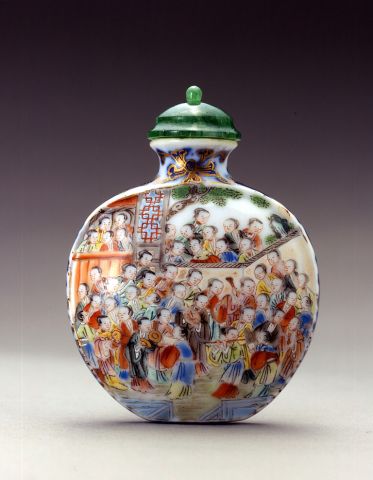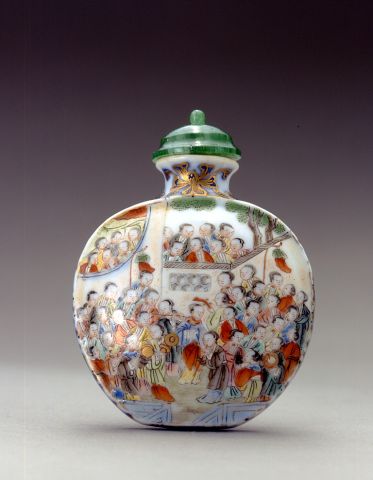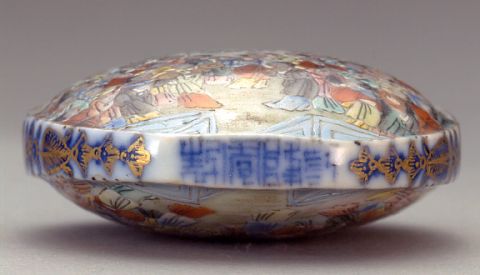



Bottle ID: 00504
ENAMELED FAMILLE ROSE, WOMEN IN VARIOUS SCENES
Date: 1770-1799
Height: 53 mm
Porcelain, hard paste, of circular form with flattened sides and convex front and back fascias, with an everted mouth and a flat base, decorated in the famille rose palette with underglaze cobalt-blue and gilding, with on each main side fifty young women, several playing musical instruments, some looking out through windows, others in a garden on a terrace, another group on the far side of a wall; the flattened sides and neck with a petal flower-head and artemis leaf design, the foot with an underglaze blue four character Qianlong nianzhi mark in seal script and of the period.
Imperial, attributed to the Palace Workshops, Jingde Zhen.
Similar Examples:
Crane Collection no. 630.
Stevens, Bob C. The Collector's Book of Snuff Bottles, 1976, p. 97, no. 296.
Low, Denis S. K. More Treasures from the Sanctum of Enlightened Respect, 2002, p. 180, no. 165.
Provenance:
Hugh Moss [HK] Ltd.
J. J. Lally & Co., New York, September 2003
Chistie's, New York, September 18, 2003, lot 143
Exhibited:
Annual Convention ICSBS Toronto, October 2007
At first sight this appears to be one of the series of late Qianlong porcelain bottles, many of which are decorated with the popular design of ‘One Hundred Boys’. The figures here, however, are quite clearly young women, distinguished by their hairstyles and the fact that they wear dresses and robes rather than the standard pantaloons and jackets of boys. The legend of the Duke of Zhou, (12th century) where the number is precisely significant, refers to the Duke who had ninety-nine children of his own and yet generously adopted one more whom he found abandoned in a field. Many of the snuff bottles with this subject matter have a high number of boys up to ninety-nine, but not necessarily exactly that figure as it serves to shift the attention from a specific myth to a general high number. The females on this bottle seem to be located in the women’s quarters of the Imperial household where concubines entertain themselves with musical performances. Perhaps as the subject of one hundred boys suggests the infinite extension of the family line, this subject suggests the good fortune to have ninety-nine concubines with the possibility of always one more! The form here is slightly more bulbous than the standard form, many examples of which have the mark written deliberately with one character incorrectly reversed. Here the correct basemark is written, suggesting that this may be slightly earlier than some of the other versions depicting boys, perhaps from the 1770s onwards. As curious as the subject may be, the quality of the enamelling is very fine with its complex composition and setting, lovely drawing, and extraordinary attention to detail. It is also in unusually good condition with no wear, even to the more delicate colours, such as iron-red enamel and gold, the only signs of age being in the slight surface degradation of the lead-based white enamel, which over a long period of time tends to crizzle at the surface.
< Back to full list
 English
English 中文
中文